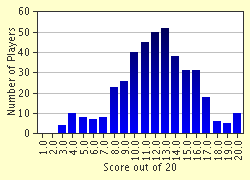Quiz Answer Key and Fun Facts
1. Considered as a work of literature, the Bible is best described as...
2. The primary device employed in Hebrew poetry such as the Psalms is:
3. Christ employed this literary form in the Gospels for most of his instruction.
4. From a Christian point of view, Abraham's near sacrifice of Isaac prefigures Christ's crucifixion. The release of a scapegoat that bears the sins of Israel prefigures Christ's atoning sacrifice. And Melchiezedek, as both a king and a priest, prefigures Christ the priest-king. These things are all ______ of Christ. What is the literary term missing from the blank?
5. Where does the first poem appear in the Bible?
6. Which of the following is an example of a short story in the Bible?
7. Which of the following is an example of an epistle?
8. Which of the following books of the Bible can best be described as a collection of short stories?
9. Which of the following books of the Bible could potentially be described as a closet drama?
10. Which of the following books of the Bible is technically classified as a history?
11. What is NOT a theme of the Bible?
12. Of the following, which one serves as a unifying factor of the Bible?
13. The Bible is replete with symbolism. What does the body symbolize in the New Testament?
14. God is symbolically depicted as a husband in which book(s) of the Bible?
15. Psalm 119 is an ______ Psalm. That is, each section of the Psalm starts with a different letter of the Hebrew alphabet.
16. "There is a way that seemeth right unto a man, but the end there of is death" is an example of a(n):
17. What is the primary literary difference between the Gospels of Matthew, Mark, and Luke?
18. Genesis is sometimes referred to as a catalog of life experiences. Which life experiences does it NOT include?
19. What is the central literary device employed in the Book of Esther?
20. Bible translations have a literary quality all of their own. Which English translation of the Bible is generally considered to be a literary masterpiece in and of itself?
Source: Author
skylarb
This quiz was reviewed by FunTrivia editor
magpie8 before going online.
Any errors found in FunTrivia content are routinely corrected through our feedback system.


